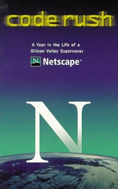In honor of the release of Firefox 3.0, I’m offering up a video that documented its very beginning in 1998 — the first open-source release of Netscape’s browser and the foundation of the Mozilla project.

Independent filmmakers followed the Mozilla team from March 1998 to April 1999, as they worked to open Netscape Communicator’s source code to the world, in a last-ditch effort to save the company. The result is an amazing snapshot of computer history, capturing the people that worked on it, the first internal beta test, the moment Jamie Zawinski uploaded the first builds publicly, the launch party, the all-hands meeting announcing the AOL acquisition, and so much more. It aired on PBS nationally in March 2000, the same month as the beginning of the dot-com collapse.
Out-of-print and never released on DVD, the used VHS copies start at $50 on Amazon. Like all the videos I release on Waxy.org, this material is commercially unavailable. If they ever come back into print, or the copyright holders contact me, I’ll take them down immediately.
Important Update (September 16): At the request of the the director, I’ve removed the video from Waxy.org and Viddler. I’ve interviewed the director about his plans for releasing the film and the unreleased footage.
Update (July 31): The documentary is back online, legally released under a Creative Commons license.
I’ve done my best to annotate the video, but many people in the film aren’t identified. I’ve left Viddler annotations open to everyone, so if you want to identify the people, places, or notable objects/events/trivia in the film, then please add your inline comments the video! (Or IM/email me and I’ll take care of it.)
The video’s now offline, but I’ve saved all the annotations. Thanks to Tman for creating the subtitle file, which can be used in video players like Media Player Classic or VLC, or simply viewed as plain text.
Now go download Firefox 3.0 and help make history!
Interviews and Appearances
- Jamie Zawinski: Left Netscape on April 1, 1999, now the owner of DNA Lounge in San Francisco
- Jim Barksdale, CEO
- Michael Toy
- Jim Roskind
- Tara Hernandez: Now an infrastructure engineer at Pixar
- Scott Collins: Now works on the Slashdot engineering team
- Jeff Weinstein
- Marc Andreessen
- Stuart Parmenter (and his parents)
- Brendan Eich: CTO at Mozilla
- David Readerman, Tech Analyst
- Po Bronson, Wired Magazine
- Kara Swisher, Wall Street Journal
- Gregg Zachary, Wall Street Journal
- Ellen Ullman, Author of Close to the Machine
